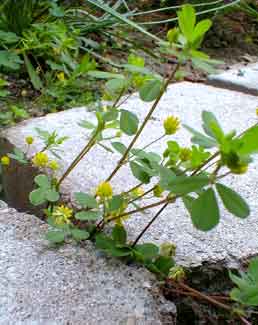
Least Hops Clover
"Our wee, gold-dusty flower, the yellow clover,
Which once in Parting for a time
That then seemed long,
Ere time for you was over."
Katharine Lee Bates
(1859-1929)
(1859-1929)
Trifolium dubium (formerly T. minus) goes by several common names, including Least Hops Clover, Small Hops Clover, Lesser Trefoil, Yellow Shamrock, & Kleiner Klee. The tiny flowers are said to resemble hops.
It is a very common mat-forming weed which erupts on roadsides & empty lots early in spring in recently disturbed soil or wherever grass, including wild meadow grasses, were chopped short at the end of the previoius year. It is only two to six inches tall, so tries to get a headstart on larger plants, germinating its previous year's seeds in January or February.
It can be the dominant weed or miniature wildflower in April. Though it may be still be blooming May through July, other plants will have grown so much as to hide it, & the early-spring mats will be overwhelmed by larger weeds & grasses. But it will still be seen until at least early July popping up in cleared gardening areas.
 The first photo from April shows the matting hops clover in a mowed roadside. The second early July photo shows a single specimen popping up between ledge stones. It tends to die back & disappear in summer heat, but can persist until early autumn where water is plentiful.
The first photo from April shows the matting hops clover in a mowed roadside. The second early July photo shows a single specimen popping up between ledge stones. It tends to die back & disappear in summer heat, but can persist until early autumn where water is plentiful. It is easily mistaken for another common wildflower, Black Medick (Medicago lupulina, but Black Medic's wee yellow flowers turn into a cluster of tiny kidney-shaped black seeds, & its trifoil leaves have pointy tips. Black Medick's range is world-wide, & Least Hops Clover is only slightly less universal in its distribution. Both plants became distributed throughout the world at least a century ago, when sailing ships routinely picked up alfalfa bails from Eurasia & Central Asia to use as passing fill-in between more profitable shipments, then sold the bails to farmers in ports of the New World & Pacific Islands. Sundry knapweeds also spread throughout the world from this practice.
Like other clovers & legume family plants generally, Hops Clover helps bind nitrogen in poor soils. Though some people fight it as an unwanted weed, it is in reality doing the soil a good deed. Though adaptable to a wide range of conditions, it tends to die out of rich soils, & does not compete well with big perennials. But for the most part, it cannot be gotten rid of, so might as well be appreciated for the real charm of so many teency bright yellow flowers & miniature trifoil leaves.
While Hops Clover annoys people who want perfection in their lawns, others never even notice it is all over the place. It is too small to make a particularly big display. It is one of the smallest of clovers, though even at that, the tiny flowers are actually made up of about two-dozen even more wee florets. Seeds for Least Hops Clover are available from major seed providers, as it is sometimes planted intentionally to help improve poor soils. It is also believed by many to have been the original Irish Shamrock, & beloved for this reason.